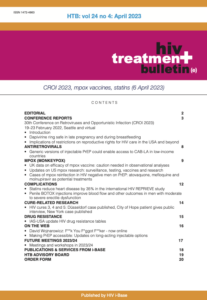HTB May/June 2023: HIV and implementation science
1 June 2023. Related: Editorial.
- Contents online
- Non-technical HTB summary: 12 news stories explained.
- Download HTB 5/6 May/June 2023 – PDF
- Subscribe to HTB by email
HIV and implementation science
A recent editorial comment in JAMA focused on the time taken – a ‘chasm’ – between advances in evidence-based medicine and their implementation into clinical practice. [1]
The article quotes this as being an average of 17 years (without noting the irony that this time is quoted from a 2011 paper published 12 years ago) and uses examples from cardiovascular care and COVID, noting that only 1 in 5 evidence-based interventions make it to routine clinical practice. [2, 3]
And although the review positively references HIV research, it would be interesting to know how HIV compares to this average.
The hopefully faster timeline for advances in HIV to become clinical practice would likely be a marker of four factors.
- Continued research into HIV treatment; with public funded research such as the UK MRC, French ANRS, European NEAT and US ACTG networks including implementation studies.
- A high awareness of results presented at medical conference before peer-review publication.
- Access to regularly updated national and international guidelines (that also allow evidence from conference presentations).
- Incorporation of implementation research by international health organisations and funders, including WHO, IAS, PEPFAR etc – sometimes called operations or operational research. [4]
This extended timeline has also been often highlighted as a problem for data on people living with HIV who are routinely excluded from phase 3 regulatory studies or underrepresented in them including by age, ethnicity, gender and sex.
A plenary talk on ART-associated weight gain, given by Andrew Carr at the recent BHIVA conference, included a slide showing a delay of 2 to 18 years in the time taken to attribute drug toxicity after drug approval. This talk is also reported in detail in this issue of HTB together with summaries of other signposted presentations. [5, 6, 7]
We conclude our reports from CROI 2023 noting that plenary talks are now available as open access. These excellent presentations by leading researchers are often underreported in community reports, and yet, similar to talks at the pre-conference investigator workshops, summarise state-of-the-art research.
The talk on the HIV reservoir and cure-related research, by Janet Siliciano, included the recent awareness that rather than steadily reducing the viral reservoir, long-term viral suppression on ART actually leads to a slight increase. [8]
The increase however is driven by the clonal expansion of latently infected cells that are transcriptional deficient, and concludes that rather than indiscriminately targeting the entire viral reservoir, future cure-related studies could instead only selectively target cells that actively contribute to viral rebound when ART is stopped.
In a small way, compressing the timeline between integrating clinical advances into practice has always been an i-Base goal, including for HTB and it is sobering to note that the field of implementational science has developed during the 22 years that we have been publishing and reporting – especially during the last 16 or so years. [9, 10, 11, 12]
This double issue of HTB also brings news of NHS England approving selected use of F/TAF for PrEP, the first liver transplant from a living donor with HIV/HCV coinfection, data on CNS-penetrating ART, a review of idiopathic lymphocytopenia, suggested lower efficacy of mpox vaccines, and, yes, more.
Happy reading.
References
- Rubin R. It Takes an Average of 17 Years for Evidence to Change Practice—the Burgeoning Field of Implementation Science Seeks to Speed Things Up. JAMA. 2023;329(16):1333–1336. doi:10.1001/jama.2023.4387. (5 April 2023).
https://jamanetwork.com/journals/jama/fullarticle/2803716 - Morris ZS et al. The answer is 17 years, what is the question: understanding time lags in translational research. Jour Royal Soc Med 104(12) https://doi.org/10.1258/jrsm.2011.11018. (16 December 2011)
- Kilbourne, A.M., Glasgow, R.E. & Chambers, D.A. What Can Implementation Science Do for You? Key Success Stories from the Field. J GEN INTERN MED 35 (Suppl 2), 783–787 (2020).
https://doi.org/10.1007/s11606-020-06174-6 - Implementation Science Perspectives and Opportunities for HIV/AIDS Research Integrating Science, Practice, and Policy. Glasgow RE et al. JAIDS Journal of Acquired Immune Deficiency Syndromes 63():p S26-S31, June 1, 2013. | DOI: 10.1097/QAI.0b013e3182920286.
https://journals.lww.com/jaids/Fulltext/2013/06011/Implementation_Science_Perspectives_and.5.aspx - Carr A. Longer-term safety of integrase inhibitors. BHIVA Spring Conference 2023 (BHIVA 2023), 24-26 April 2023, Gateshead.
https://www.bhiva.org/file/645ba42c50868/Andrew-Carr.pdf (PDF slides)
https://vimeo.com/823052252 (webcast) - Taylor K. Overview of weight gain, integrase inhibitors and ART HTB (1 June 2023).
https://i-base.info/htb/45587 - Collins S. Selected webcasts at BHIVA 2023. HTB (1 June 2023).
https://i-base.info/htb/45467 - Collins S. Viral reservoir increases on long-term ART: new strategies for a cure. HTB (1 June 2023).
https://i-base.info/htb/45399 - Schackman BR. Implementation science for the prevention and treatment of HIV/AIDS. J Acquir Immune Defic Syndr. 2010 Dec;55 Suppl 1(Suppl 1):S27-31. doi: 10.1097/QAI.0b013e3181f9c1da.
https://www.ncbi.nlm.nih.gov/pmc/articles/PMC3058234 - The journal Implementation Science was launched in 2006.
- The first US NIH on Implementation Science was held in 2007.
- Boulton R et al. The cultural politics of ‘implementation science’. J Med Humanit 41, 379–394 (2020). https://doi.org/10.1007/s10912-020-09607-9.
https://link.springer.com/article/10.1007/s10912-020-09607-9


